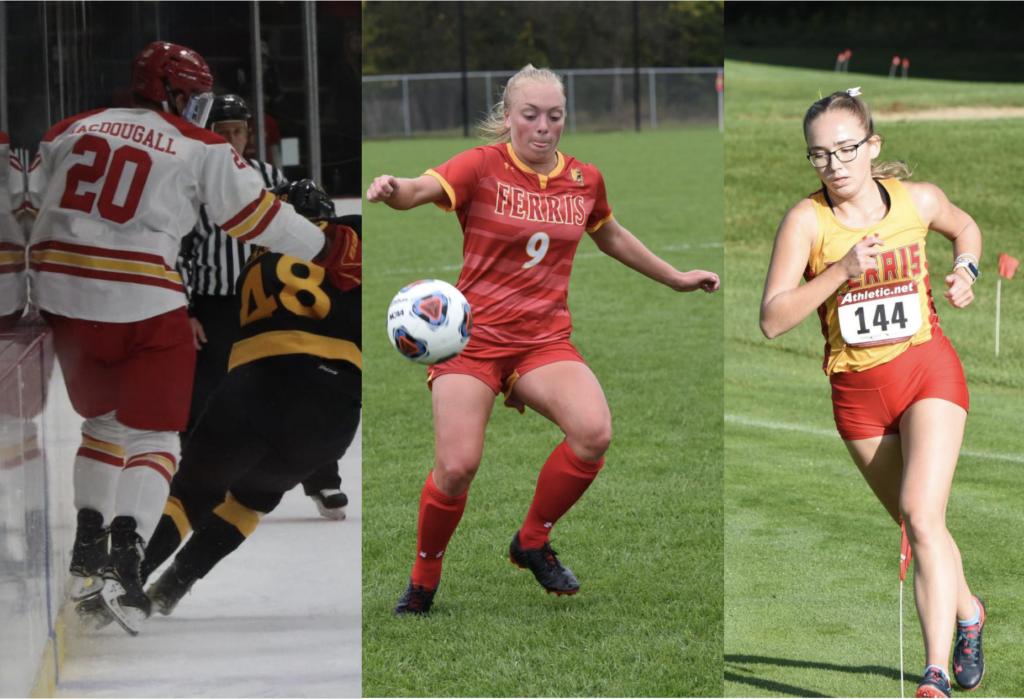NBA all-star and esteemed athlete Kareem Abdul-Jabbar once said, “One man can be a crucial ingredient on a team, but one man cannot make a team.”
At the college level, recruitment is necessary to cultivate and maintain an athletic team. Within Bulldog Athletics many groups of stellar individuals have come together to win National Championships as well as regional and conference titles.
As for Ferris’ renowned hockey team, there is a focus on “bringing in good citizens that are mature and coachable,” coach Bob Daniels said.
Daniels explains that recruitment looks different for hockey than for other collegiate sports since most players go on to play in junior hockey leagues before playing in college. This means that recruits are typically older than high school age and are often 19 or 20 years old. “We start looking at players when they are 15 or 16 and then keep an eye on them as they play in junior leagues,” Daniels said.

Some skills that Daniels highlighted included skating ability, puck handling and vision. In regards to team atmosphere, Daniels said that typically the recruit spends time with players to see how they fit. The coaches collaborate to select recruits and take into account what the players thought.
As for the current pandemic, “COVID changed everything,” Daniels explained that the NCAA is not allowing on-the-road recruitment for any division one schools, meaning that all of his recruitment is virtual. Without a physical visit, prospective athletes are not able to spend time with the other players or visit campus in person.
“Thankfully, we are able to do virtual visits and watch players from recorded games on Hockey TV,” Daniels said.
Jared Kelsh, the cross country and track coach, highlighted that grit and work ethic are valuable qualities that make a prospective athlete stand out. “I am most impressed by the ability to come back from a failure and push forward to continue to be successful.”
As for the recruitment process, potential team members often stay on an official overnight visit. The track and cross country teams bring in high school and transfer students as recruits each year.
“Onsite and official overnight visits are key to figuring out if the athlete is going to fit in with the program and if the program is going to be a good fit for the athlete,” Kelsh said.
COVID-19 has also affected recruiting for the cross country and track teams in several ways.
“There are many limitations to ensure the safety of everyone on campus. These things have made it very difficult to get the full Ferris State experience.”
This full experience would usually include campus tours, team bonding, practice with the team and an overnight stay in the dorms. Many of these activities to get to know a recruit are not allowed.
“To add another layer, competition has been very different, and the amount of people to spectate each event has been limited. This makes assessing each athlete more challenging,” Kelsh said.
Typically, coaches watch a prospective athlete race or compete in person if they are being considered. As meets are limited to only family members and film for running is unavailable, this makes recruitment especially hard.
Greg Henson, the head soccer coach at Ferris, shared his perspective on the current pandemic. Although the process has changed, Henson consistently approaches recruitment with the same attitude. Above all other qualities, he values character in prospective athletes.
“Talent never trump’s character. We are looking for good athletes and good students, but most importantly, good people to join our program,” Henson said.
The athlete should not only fit in with the team but “the school must have a strong academic program in the field they plan to study and the soccer program should be a good fit for the player’s goals. Socially, the school should match what they are looking for in terms of size, location, and distance from home,” Henson said.
Similar to hockey, track, and cross country, the virus has made campus visits more challenging and turned the scouting focus from live games to studying film.
“In the end, it’s the same challenges for every program across the country and you either embrace it and move forward, or you fall behind.”
